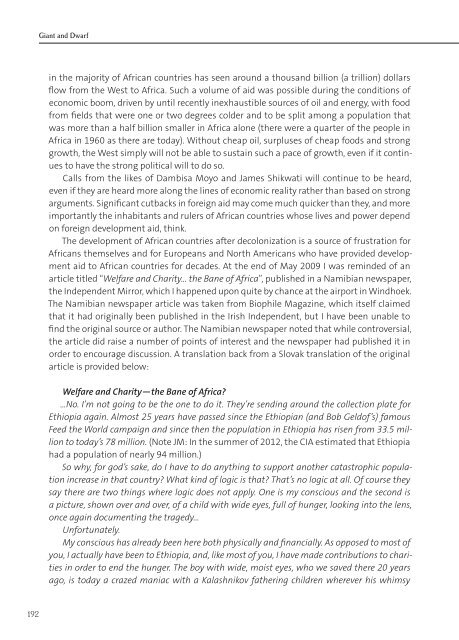Giant_and_Dwarf-FIN
Giant_and_Dwarf-FIN
Giant_and_Dwarf-FIN
You also want an ePaper? Increase the reach of your titles
YUMPU automatically turns print PDFs into web optimized ePapers that Google loves.
<strong>Giant</strong> <strong>and</strong> <strong>Dwarf</strong>in the majority of African countries has seen around a thous<strong>and</strong> billion (a trillion) dollarsflow from the West to Africa. Such a volume of aid was possible during the conditions ofeconomic boom, driven by until recently inexhaustible sources of oil <strong>and</strong> energy, with foodfrom fields that were one or two degrees colder <strong>and</strong> to be split among a population thatwas more than a half billion smaller in Africa alone (there were a quarter of the people inAfrica in 1960 as there are today). Without cheap oil, surpluses of cheap foods <strong>and</strong> stronggrowth, the West simply will not be able to sustain such a pace of growth, even if it continuesto have the strong political will to do so.Calls from the likes of Dambisa Moyo <strong>and</strong> James Shikwati will continue to be heard,even if they are heard more along the lines of economic reality rather than based on strongarguments. Significant cutbacks in foreign aid may come much quicker than they, <strong>and</strong> moreimportantly the inhabitants <strong>and</strong> rulers of African countries whose lives <strong>and</strong> power dependon foreign development aid, think.The development of African countries after decolonization is a source of frustration forAfricans themselves <strong>and</strong> for Europeans <strong>and</strong> North Americans who have provided developmentaid to African countries for decades. At the end of May 2009 I was reminded of anarticle titled “Welfare <strong>and</strong> Charity... the Bane of Africa”, published in a Namibian newspaper,the Independent Mirror, which I happened upon quite by chance at the airport in Windhoek.The Namibian newspaper article was taken from Biophile Magazine, which itself claimedthat it had originally been published in the Irish Independent, but I have been unable tofind the original source or author. The Namibian newspaper noted that while controversial,the article did raise a number of points of interest <strong>and</strong> the newspaper had published it inorder to encourage discussion. A translation back from a Slovak translation of the originalarticle is provided below:Welfare <strong>and</strong> Charity—the Bane of Africa?...No. I’m not going to be the one to do it. They’re sending around the collection plate forEthiopia again. Almost 25 years have passed since the Ethiopian (<strong>and</strong> Bob Geldof’s) famousFeed the World campaign <strong>and</strong> since then the population in Ethiopia has risen from 33.5 millionto today’s 78 million. (Note JM: In the summer of 2012, the CIA estimated that Ethiopiahad a population of nearly 94 million.)So why, for god’s sake, do I have to do anything to support another catastrophic populationincrease in that country? What kind of logic is that? That’s no logic at all. Of course theysay there are two things where logic does not apply. One is my conscious <strong>and</strong> the second isa picture, shown over <strong>and</strong> over, of a child with wide eyes, full of hunger, looking into the lens,once again documenting the tragedy...Unfortunately.My conscious has already been here both physically <strong>and</strong> financially. As opposed to most ofyou, I actually have been to Ethiopia, <strong>and</strong>, like most of you, I have made contributions to charitiesin order to end the hunger. The boy with wide, moist eyes, who we saved there 20 yearsago, is today a crazed maniac with a Kalashnikov fathering children wherever his whimsy192


